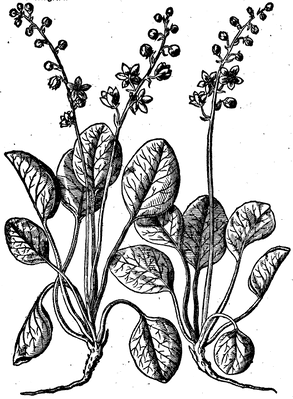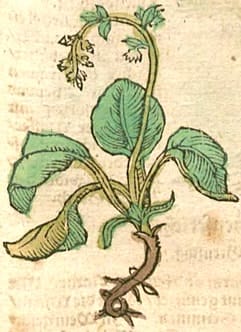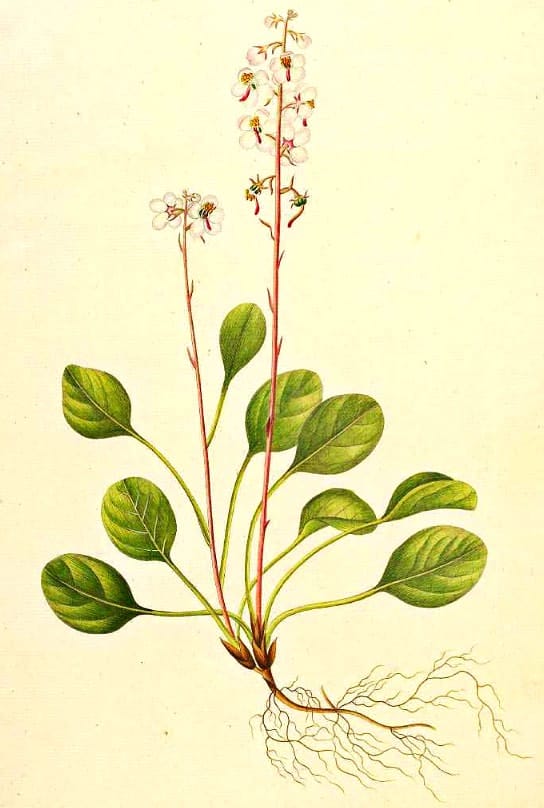Pyrola, Wintergreen, Lu Xian Cao 鹿衔草
Wintergreen, Wild BeetLu Xian Cao (TCM)
 Pyrola rotundifolia
Pyrola rotundifoliaNew Kreuterbuch, Matthiolus, 1563
 Pyrola rotundifolia
Pyrola rotundifoliaKurtzes Handtbuchlein, Ryff, 1599
 Pyrola rotundifolia
Pyrola rotundifoliaFlora Danica [G.C. Oeder et al],. 1816
Botanical name:
Pyrola rotundifolia (Europe)
Various local species are used including:
- P. rotundifolia var. chinensis (syn. P. calliantha), P. decorata (TCM)
- P. japonica (Japan, North-East China)
- P. incarnata (Northern China)
- P. atropurpurea (West China)
- P. minor (Xin Jiang)
- P. szechuanica (Sichuan)
- P. oreodoxa (Yunnan)
- P. renifolia (Inner Mongolia)
Parts used:
Herb
Temperature & Taste:
Warm, dry. Sweet, Bitter, Astringent
Classification:
D. Clear Wind and Damp
Uses:
1. Clears Wind-Damp, Strengthens Sinews and Bones: (TCM, West)
-Wind-Damp pain of the muscles and joints; Arthritis, Rheumatism
-Weakness of the Lower Back and legs
-Cramps, Convulsion, Epilepsy (West)
-also used for Stones in the West
2. Clears Damp, Promotes Urine: (West, TCM)
-Edema, Dysria, Water Retention
-Urinary Tract Infection (TCM)
-Nephrosis; Kidney diseases with Edema, proteinuria
-also been used for Urinary Ulcers and Prostatitis (West)
3. Moves the Blood, Stops Bleeding, Promotes Healing: (TCM, West)
-Coughing Blood (TCM)
-Uterine Bleeding, excessive Menstruation
-to stop Nose-bleeding, Wirtzung (1598) recommends to hold a leaf in the mouth
-Bleeding from Trauma; helps promote healing of Wounds (Vulnerary)
-also for Hernia
-it was also used for Blood Stagnation in the West (Botanicon Continens Herbarum, Theodore Dorsten, 1540)
-used for Tumors and Cancers
4. Strengthens Lungs, Stops Cough: (TCM)
-chronic Cough from Lung weakness
-in TCM for Cough from Kidneys failing to ‘grasp Qi’ (Cough from Lung and Kidney deficiency)
-Consumption (TCM, West)
5. Nourishes the Heart, Restrains Sweating: (TCM, West)
-Palpitations with Night Sweats
-‘inflammation rising upon pains of the Heart’ (Culpeper)
6. Externally:
-applied to stop bleeding (powder, carbonised powder, or fresh herb)
-applied to boils, carbuncles (West)
-applied to Wounds (West, fresh leaves or juice applied)
-Foul Ulcers, Cancers, Fistulas (Culpeper)
-washes and douches for Uterine Ulcers
Dose:
To move the Blood, it is decocted in Wine, or the powder is taken with wine.
Decoction: 9–15 grams
Powder: 2–4 grams
Comment:
1. P. rotundifolia, the standard Western species, is also used as a source in North-West China’s Xin Jiang region as a source for Lu Xian Cao. This indicates the species used in West and TCM to be synonymous.
2. The Oil of Wintergreen is presently the most commonly used part of this plant in the west, being used topically. It’s primarily applied topically for pain and inflammation.
3. Should not be confused with Gaultheria fragrantissima, also called Wintergreen which is the American Wintergreen.
Substitute:
1. Birch Tar Oil is almost identical to Wintergreen oil in use and has been used as a substitute. It is obtained after destructive distillation of the Birch bark.
2. Oil obtained from Gaultheria fragrantissima (Indian Wintergreen) is used as a substitute for Wintergreen oil.
Main Combinations:
1. Wind-Damp Joint disease:
i. chronic degenerative joint disease, Pyrola Lu Xian Cao with Atractylodes Bai Zhu and Alisma Ze Xie
ii. Chronic Joint pain, Pyrola Lu Xian Cao with Cynanchun Xu Chang Qing and Turmeric (Jiang Huang)
iii. chronic back pain with weakness of the back, Pyrola Lu Xian Cao with Mistletoe (Sang Ji Sheng), Eucommia Du Zhong, Achyranthes Niu Xi
iv. Rheumatoid Arthritis, Wintergreen and Kelp as a plaster topically.
2. Bleeding:
i. Coughing Blood, Pyrola Lu Xian Cao with Bletilla Bai Ji
ii. Uterine Bleeding or Blood in the Stool, Pyrola Lu Xian Cao with Burnet root charred (Di Yu)
iii. Excessive Menstruation, Wintergreen with Ladies mantle
iv. Nose-bleeding; Wintergreen and Tormentil root are held in the Mouth (Wirtzung)
3. Blood Stagnation, Wintergreen and Sanicle, decocted in wine. (Botanicon Continens Herbarum, Theodore Dorsten, 1540)
4. Chronic Cough:
i. from Lung weakness, Pyrola Lu Xian Cao with Schisandra Wu Wei Zi, Walnut (He Tao)
5. Consumption, Pyrola Lu Xian Cao is stewed with Pig’s Feet
6. Wounds, Trauma:
i. Wintergreen with Sanicle, Paul’s Betony, Golden Rod, Jujubes (as in Vulnerary Infusion)
ii. Wintergreen, Plantain, St. John’s wort, Sanicle, added to Lime Water
iii. Wintergreen with Sarsaparilla, St. John’s wort, Agrimony, Plantain, Sanicle (as in Decoction for Wounds)
iv. Wintergreen, Tormentil, Comfrey, Sanicle, Vervain, Periwinkle (as in Universal Vulnerary Decoction)
v. Wintergreen, Burnet Saxifrage root, Arum root, Sanicle, Ground Ivy, Speedwell, Lesser Centaury (as in Powder for Vulnerary Decoction)
vi. Wintergreen oil, Myrrh tincture, Oregano oil, Camphor, Spirits of Turpentine, mixed with alcohol as a liniment (as in Good Samaritan Liniment)
vii. form a salve from the fresh herb boiled in Hog’s lard, or in wax and oil with turpentine. This was highly extolled for Trauma
7. Hernia, Wintergreen with Sage, Rupturewort, Agrimony, Soloman’s Seal, Comfrey root, Tormentil, Bupleurum rotundifolium
8. Breast Cancer, Wintergreen and Ground Ivy, boield in Wine (‘Highly Commended’) (Platerus Golden Practice of Physick, Plater, 1664)
Major Formulas:
Vulnerary Infusion
Decoction for Hernia
Decoction for Wounds
Universal Vulnerary Decoction (Joseph du Chesne)
1. Good Samaritan Liniment:
i. Tincture of Myrrh, Oil of Wintergreen (4 fl. oz. each), Oregano oil (2 fl. oz.), Oil of Sassafras, Oil of Hemlock, Spirit of Turpentine, Tincture of Capsicum, Tincture of Opium (1 fl. oz. each), Camphor (2 oz.), Chloroform (1 ½ fl. oz.), Alcohol (4 pints).
Cautions:
None noted
Toxicity:
No toxicity was noted in mice given 60g/kg for 1 week.
